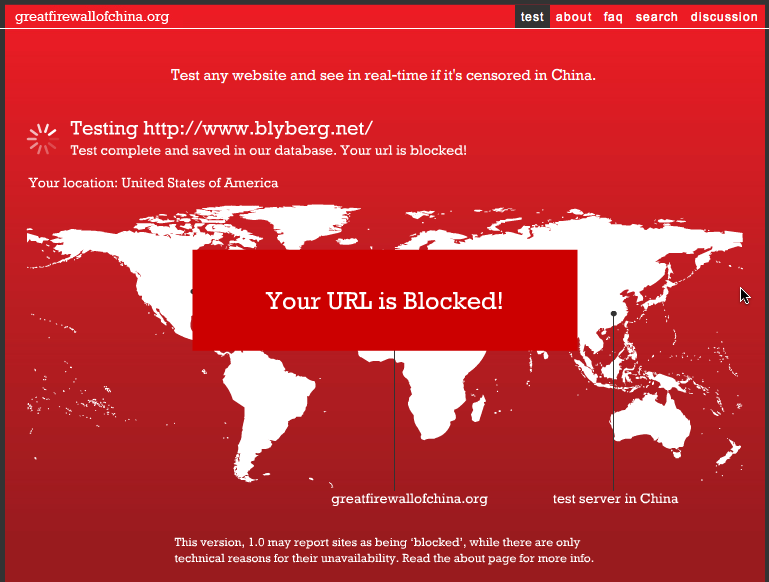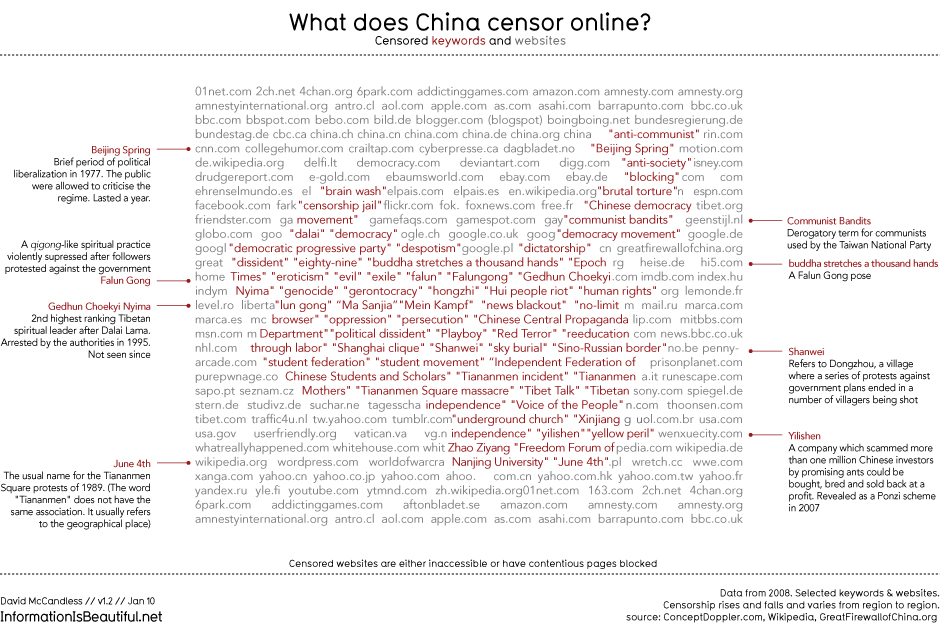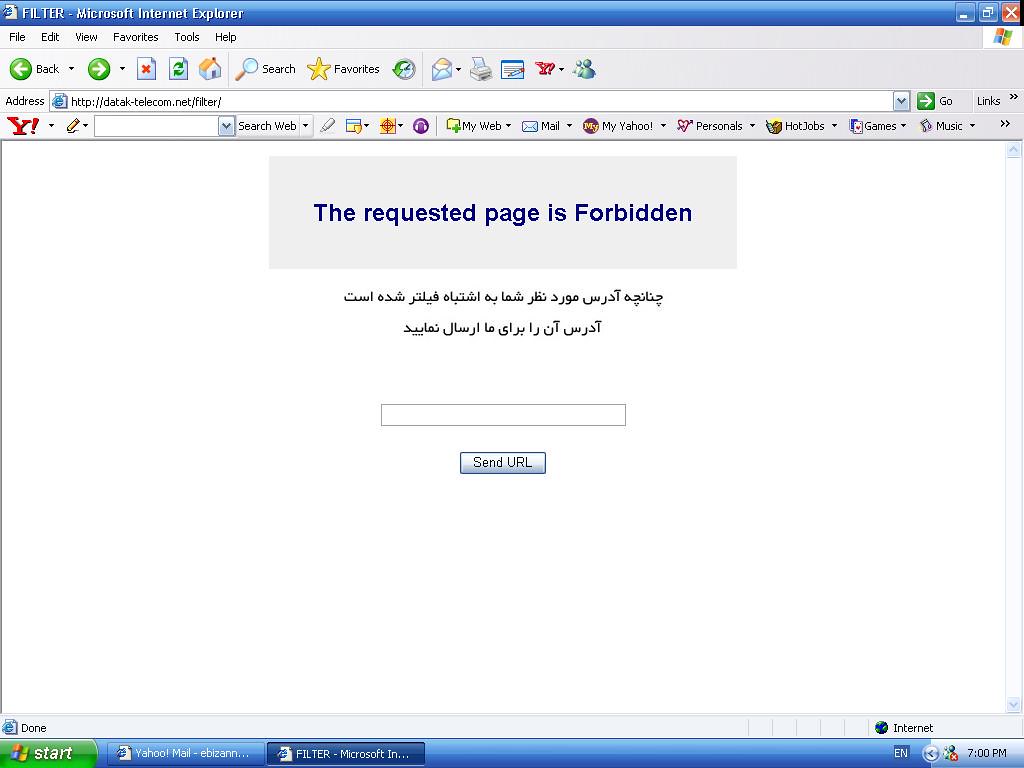For the dictatorial nations of China and Iran the internet is viewed as a tilted lens, thought to be able to be restored through ‘appropriate censorship practices’, however such practices are in violation of freedom of expression and access to information human rights, extending outdated theology of authoritarian rule, reverting to barbaric times.
1. Motivations for Internet Censorship
The complex interplay involved in the relationship that dictatorial nations have with the internet is entirely entrenched in the removal of access to information. Information is knowledge, knowledge is power. In the current global perimeters, lack of exposure to information sources is synonymous with censoring internet access. The “mechanics of censorship” (McPhail & Noorlander, 2007) for the dictatorial countries of China and Iran is implemented in distinctive ways reflecting each nations strict policies; for Iran this is derivative of their religious ideologies. For both nations censorship continues the acquiescence and conformity to the ruling body, understood as the overwhelming motivation, whereby resistance can be rebuffed. These nations intentionally refute the internet’s biggest advantage of “emancipatory potential” instead abusing it for the “political repression of dissident” (Warf, 2010).
China

CC BY 2.0 DEED
The motivations behind China’s extensive internet censorship are abhorrently clear, to maintain the power of the party, at whatever cost. By controlling the internet, China controls the narrative. Most notably is the extensive censorship apparatus, the Great Firewall of China, so comprehensive its unlike anything of its kind, fixates on foreign interference and the possibility of influence to its citizens (Chen & Yang, 2019). Thus, with such labyrinthine technologies (including but not limited to keyword filters and IP address moderation), China’s methodology reigns, however not without resistance emanating from the freedom that virtual private networks provide. The totalitarian control on all aspects of life for Chinese citizens debilitates any other options, other than what has been authorised. From education to politics and healthcare, individuals are only exposed to one side of the coin, substantiated by China’s response to the COVID-19 pandemic. The outbreak’s first reporting, via China’s WeChat was reproved for “disrupting public order” (Li et al., 2020). A pinnacle example of China’s annihilation of sensitive topics, above all when disseminated through the internet, at the hands of substantial outreach potential afforded by the internet.
Iran

%2852383779726%29.jpg,
CC BY-SA 2.0 DEED
Contrary to China, motivations behind Iran’s internet censorship reeks of concerns about religious morality; controlling the religious narratives. Politics and religion are inextricably linked in Iran; thus, any radical religious motivations are simultaneously political in nature. At the forefront of the Iranian government’s actions is the preservation of Islamic ethics. More accurately, Islamic ethics mentioned in the Quran are “the construction of knowledge favourable to the stability of state power” (Rahimi, 2015). Iran and the West are not destined to ruminate together, or even achieve a state of symbiosis, which is particularly strengthened by the Western notion that Islam is “retrogressively backward, one-dimensional, inherently separate and “Other” to the West, as well as enemy to modernization and western values” (Hassan et al., 2017). The West promotes ideals that endanger the “clinical” religious purity of Iran, thus, criminalising “activities that betray the adoption of western lifestyles and the expression of dissent against the regime” (Karagiannopoulos, 2012). The most relevant evidence where internet censorship intensified was following the uploading of the video showing the beating to death of Mahsa Amini in September of 2022, a young women killed by Iran’s morality police for “improperly” wearing her hijab on the street.
2. Methods of Internet Censorship
China

CC BY-NC 2.0 DEED
The Chinese Communist Party’s methods of control echo remnants of its predecessors, however the emergence of the internet sees traditional excessively forceful measures amalgamate with internet censorship to surveil and repress opposition. The supremacy of the incumbent political dictatorship only exists when the fear of persecution and reigning terror exceeds the resistance. China has implemented both overt and covert methods of control to reduce the symptomatic conflicts that arise when individuals have freedom stripped, leaving them in a state of ultimate state supremacy. China’s covert method of control acquiesces citizens by providing home grown applications and search engines (Weibo, Baidu, WeChat etc.) as a replacement following aggressive overt action in banning many if not all foreign applications (Instagram, Facebook, WhatsApp etc.), limiting Western ideological influence. However, according to Dowell (2006) “instead of opening up China to free thought, the enormous attraction of the Chinese market appears to be corrupting Western companies”. With “nearly a century of experience running information operations” (Stanford University, 2020), the intention of the Chinese government is abundantly clear, not having control over citizens lives, in this case internet consumption, poses a threat of resistance and opposition to the “domestic monopoly on power” (Stanford University, 2020).
Iran

CC BY-SA 2.0 DEED
Following the aforementioned death of Mahsa Amini, internet censorship has reached extremist severity, with multiple arrests and executions manifesting in the public sphere based on violations of Iran’s internet laws. The most troubling blurring of public and private boundaries emanates from the Islamic Revolutionary Guard Corps, also identified as the morality police, in possession of more than half of the shares of the Telecommunications Company of Iran, the incumbent telephony operator in Iran. The newest methodology of alarming concern is the digital curfews, previously trialled back in 2019 with a 5 day internet shutdown, that ceases internet flow and access during the hours when protests have been occurring most frequently. The state’s methods of control have extended to include DNS encryption since the inception of the protest in September of 2022 whilst also including blocking and removing the widely used virtual private network system that regularly allows Iranian citizens to circumvent authoritarian regime and use a censorship free internet, alongside banned social media platforms (Campbell, 2023).
3. Human Rights and the Dividends of Internet Censorship
Internet censorship comes at a considerable human rights cost. Conversely, censorship has political, economic and social benefits for these nations, alongside protecting against cybersecurity threats, counterterrorism and espionage, securing critical internet infrastructure. For China, censorship maintains economic prosperity, restricting information about income inequality, notably, internet censorship increasing during period of economic strife. China’s ban on foreign internet channels, forces its internet users to rely on China’s own e-commerce industry, self-insulating their economy, mirroring the US republican foreign policy of isolationism. Thus, retaining the position of the 2nd largest economy in the world. When contending with foreign markets, China “leverages its market power to ensure foreign corporations and their employees avoid criticizing its policies outside of China” (Durkin, 2020). Hence, internet censorship remains a necessity to help prosper this nation, which consequently prospers all other around the world.
For Iran, censorship denotes protecting the national security harmful content and disinformation, effects of such having been described as detrimental to social order and stability. Internet censorship ascertains that the Iranian people are the ultimate beneficiaries from volatile and graphic content, unsuitable for the public often from outside the country as domestic browsing is significantly more pleasant than accessing sites based outside the country (Anderson, 2016).
It is critical to note that these perceived dividends provided by internet censorship support the respective governing bodies of each country, not the people. Both nations are directly in violation of many human rights, particularly when excessive force is applied in order for citizens to comply to inane regulations. However, China and Iran’s governments believe that the extensive censorship they currently possess is straightening the corrupt lens of the Western world’s freedom. Let it be known, media censorship is a hallmark of authoritarian regimes (Tai, 2014).
References
Amnesty International. (2020, November 16). Iran: Internet deliberately shut down during November 2019 killings – new investigation. Amnesty International. https://www.amnesty.org/en/latest/press-release/2020/11/iran-internet-deliberately-shut-down-during-november-2019-killings-new-investigation/
Anderson, C. (2016, September 23). How Iran Is Building Its Censorship-Friendly Domestic Internet. Wired. https://www.wired.com/2016/09/how-iran-is-building-its-censorship-friendly-domestic-internet/
Campbell, E. (2023, January 24). Mahsa Amini and the future of internet repression in Iran. Middle East Institute. https://www.mei.edu/publications/mahsa-amini-and-future-internet-repression-iran
Chen, Y., & Yang, D. Y. (2019). The Impact of Media Censorship: 1984 or Brave New World? American Economic Review, 109(6), 2294–2332. https://doi.org/10.1257/aer.20171765
Churchill, O. (2022, April 20). Growing isolation puts China, US “on the brink” of a new cold war. South China Morning Post. https://www.scmp.com/news/china/diplomacy/article/3174845/growing-isolation-puts-china-us-brink-new-cold-war
Dowell, W. (2006). The internet, censorship, and China. Georgetown Journal of International Affairs, 7(2), 111-120.
Durkin, A. (2020, August 6). China’s internet censorship and trade. Hinrich Foundation. https://www.hinrichfoundation.com/research/article/tech/china-internet-censorship-trade/
Hassan, I., Azmi, M. N. L., & Abubakar, U. I. (2017). Framing Islam in News Reporting: A Comparative Content Analysis. Asian Social Science, 13(10), 112. https://doi.org/10.5539/ass.v13n10p112
Herman, A. (2023, February 3). WeChat: China’s Other Trojan Horse. Forbes. https://www.forbes.com/sites/arthurherman/2023/02/03/wechat-chinas-other-trojan-horse/?sh=711d4c6a3d84
Karagiannopoulos, V. (2012). The Role of the Internet in Political Struggles: Some Conclusions from Iran and Egypt. New Political Science, 34(2), 151–171. https://doi.org/10.1080/07393148.2012.676394
Li, X., Cui, W., & Zhang, F. (2020). Who Was the First Doctor to Report the COVID-19 Outbreak in Wuhan, China?. Journal of nuclear medicine : official publication, Society of Nuclear Medicine, 61(6), 782–783. https://doi.org/10.2967/jnumed.120.247262
McPhail, S., & Noorlander, P. (2007). The Mechanics of Censorship.
Rahimi, B. (2015). Censorship and the Islamic Republic: Two Modes of Regulatory Measures for Media in Iran. Middle East Journal, 69(3), 358–378. http://www.jstor.org/stable/43698258
Sadjadpour, K. (2023, September 12). What’s Happened to Iran a Year After Mahsa Amini’s Death. TIME. https://time.com/6312691/mahsa-amini-death-anniversary-iran/
Tai, Q. (2014). China’s Media Censorship: A Dynamic and Diversified Regime. Journal of East Asian Studies, 14(2), 185–209. http://www.jstor.org/stable/26335242
University, S., Stanford, & California 94305. (2020, August 20). New White Paper on China’s Full-Spectrum Information Operations. Cyber.fsi.stanford.edu. https://cyber.fsi.stanford.edu/io/news/new-whitepaper-telling-chinas-story
Warf, B. (2010). Geographies of global Internet censorship. GeoJournal, 76(1), 1–23. https://doi.org/10.1007/s10708-010-9393-3

